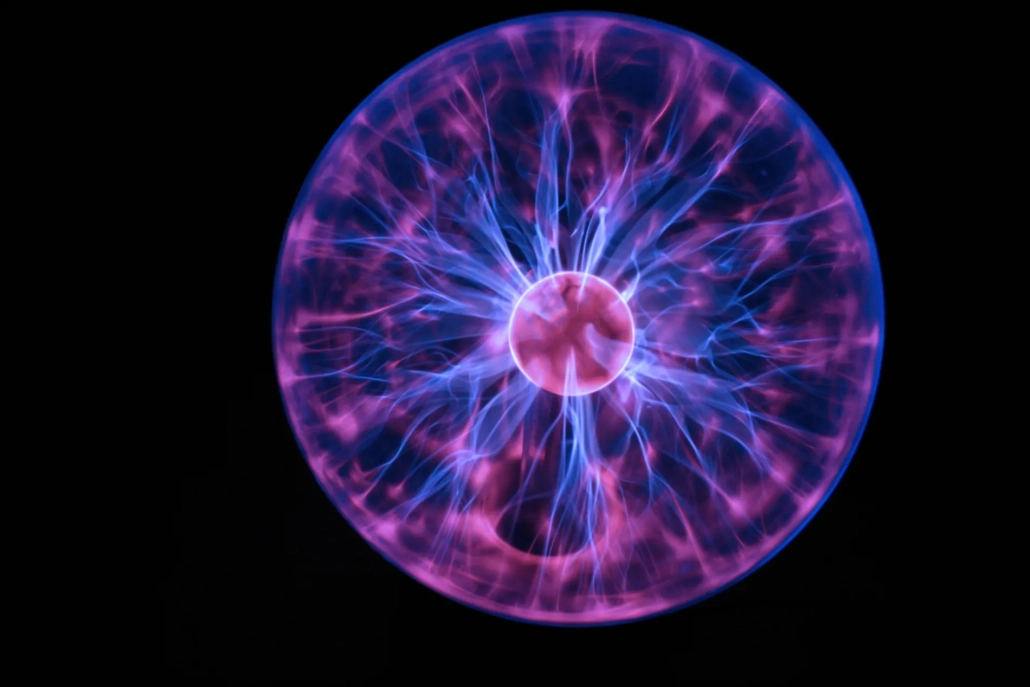WHAT IS PLASMA?
If sufficient energy is provided to one or more gasses in a vacuum chamber the brake up of atomic links is reached, with the formation of electrons, positive ions, radicals and UV.
This condition is called plasma and also known as the fourth state of matter, called plasma.
In space, plasma such as the polar lights, luminous flashes, etc. are present. Hot or cold plasma can be generated.
Gambetti Kenologia produces only cold plasma systems, where the plasma is generated by subjecting low-pressure gas/gases in a vacuum chamber to an high frequency electromagnetic field, triggering a visible light discharge.
In this way, an highly reactive process gas, which reacts on the surface of the product to be treated, is generated.
Plasma, being a particularly energized state of matter, possesses unique properties that distinguish it from solids, liquids, and gases.
For every plasma treatment process suitable parameters must be found, modifying the frequency, the power, the gas flow and ratios and the process time.
Nuovi paragrafi di testo aggiunti:
Plasma in physics: the fourth state of matter
Understanding what is plasm energy and which are the temperatures of plasma is crucial for knowing and controlling natural and industrial processes involving plasma gas. Plasma in physics represents the fourth state of matter, characterized by the ionization of its gases.
When a gas receives sufficient energy, electrons from its atoms are stripped away, creating a lot of charged particles: free electrons and positive ions. This state is known as plasma, but what is plasma physics? It is the interdisciplinary study of the unique properties of this form of matter, which differs from solids, liquids, and gases.
Plasma physics: definition and properties
By definition, plasma has excellent electrical conductivity, derived from the presence of free charges. This characteristic makes plasma highly responsive to electric and magnetic fields, paving the way for a wide range of scientific and technological applications: from astrophysics to nuclear reactor physics, plasma electricity plays an important role in the study and development of advanced technologies.
Solar plasma and extreme temperatures
A famous example of high-temperature plasma is solar plasma, found in the Sun’s corona and photosphere: the high temperatures in the stellar core ionize elements, creating an environment of intense heat and radiation.
The study of solar plasma has led to a better understanding of stars and, importantly, to the development of terrestrial nuclear reactors based on fusion, where plasma must be maintained at extremely high temperatures to generate energy.
Electrical plasma and its applications
Now, let’s discuss electric plasma: it is a particularly dynamic and controllable form of plasma, created using high-frequency electromagnetic fields or other sources of electrical energy. In this case, the plasma state can reach very high temperatures, varying depending on the type of gas and the applied energy.
When the energy and temperature of plasma are controlled using high-frequency electromagnetic fields, the gas is ionized at low pressure and transformed into a highly reactive state.
The ability to manipulate electric plasma makes it essential in a wide range of technological and scientific applications: therefore, this technology is used across various sectors, from precision electronics to medicine and aerospace industries. In industrial applications, electric plasma is used for depositing thin films on materials, treating surfaces to enhance adhesion or resistance to wear, or for producing advanced electronic devices and products.
Moreover cold plasma, generated through methods like controlled electrical discharges or laser radiation, finds application in medical instrument sterilization and much more.
Ongoing research into electric plasma aims to optimize ionization processes by precisely controlling parameters such as frequency, power, and gas composition, to develop new technologies that fully exploit its unique properties.
Plasma science reveals new perspectives and innovative applications, pushing the boundaries of our understanding of matter and its most extreme manifestations. Studying how plasma is made and manipulating plasma not only allow us to better understand the workings of the universe, but also promises advanced technological solutions that could change many industrial and scientific sectors, in the next future.


